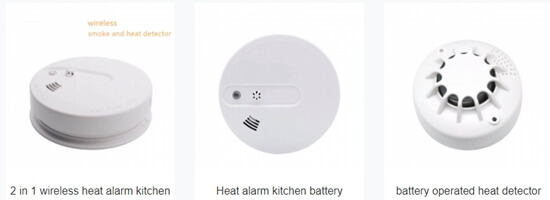A heat detector (or battery powered heat detector ) is a property-safety sensor that responds to very high temperatures that are only present during fires. Standalone heat detectors(also called battery powered heat detector) are often used in room where smoke detectors may cause false alarms.
Heat detectors usually take longer to respond to a fire than smoke detectors.

We have many types heat detectors such as wireless heat detector/wired heat detectors/battery powered heat detector,no matter which type detector, their The physical working principle is as follows:
A heat detector works by sensing unusually high temperatures and/or sudden increases in temperature. A heat detector that responds to unusually high temperatures is called a fixed heat detector.
For example, a fixed heat alarm might activate upon sensing a temperature of 135 degrees Fahrenheit or higher. A heat detector alarm that responds to sudden increases in temperature is called a rate-of-rise heat alarm. For example, a rate-of-rise heat alarm might activate upon sensing a temperature increase of 15 degrees Fahrenheit or higher in a single minute. Some heat alarms may offer both fixed temperature sensing and rate of rise temperature detection.
The thing to remember is that heat detectors do not usually detect fires as quickly as smoke detectors. For that reason, smoke detectors are used in most locations. But you might still use heat detectors(such as battery powered heat detector) in locations where smoke detectors may cause false alarms. The only reason to use standalone battery powered heat detector is for locations where a smoke detector may result in false alarms.
